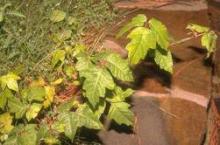After a long, cold, snowy winter, I actually cheered at the first site of a purple crocus emerging from my front yard. Spring brings with it warmer weather, outdoor sports, blooming flowers, and trees full of leaves. Unfortunately, it also brings some less-desirable plants with it as well, such as poison ivy, poison oak, and poison sumac. As your patients happily emerge from their houses to play outside, some will inevitably end up in your offices itching and uncomfortable from contact dermatitis. As many as 50% of people who come in contact with these plants will have a reaction.
As with most illnesses, prevention is the best cure. Once a child (or adult, for that matter) has been exposed to poison ivy, oak, or sumac, from the genus Toxicodendron, the best you can do is try and relieve symptoms until the dermatitis resolves on its own.
The first step in prevention is recognition. The old adage, “Leaves of three, let them be” – describing three leaflets, often with small black dots, arising from a reddish stem – is generally accurate; however, there are some exceptions to this rule depending on the type of plant (particularly poison sumac) and geographic location. If you aren’t already aware of the species in your area, it is worth spending a few minutes researching what types of plants are common locally (www.cdc.gov/niosh/topics/plants).
Avoiding all contact with these plants is best; long pants, shirt sleeves, and gloves help avoid exposure, but this is often not practical for a child playing outside, and urushiol (the allergenic substance on the surface of these plants) adheres to clothes, and pets, and other things. … If known or potential exposure has happened, it is best to wash all areas of your skin as soon as possible, particularly focusing on hands and under your fingernails. There are a variety of products such as Tecnu, Zanfel, and Goop Hand Cleaner, which are effective at preventing reactions after exposure has occurred (and, in the case of Zanfel, can also relieve symptoms if a reaction occurs); however, these products can be pricey and not always on hand when you need them. Topical dish washing soap has been found in one study to be an effective alternative (Dial Ultra Dish washing Soap [no longer available] was the product used, but any surfactant-based dish washing detergent is likely effective).*
However, speaking from experience, even the best efforts to avoid or minimize exposure are not always successful. Symptoms usually occur within the first 4 days of exposure, with lesions cropping up at different times depending on the location and type of skin and intensity of exposure to urushiol. Lesions are typically very itchy and can be plaques, papules, vesicles, or bullae. It is commonly believed that the lesions can be “spread” through contact with the fluid inside these vesicles or other parts of the lesions; however, this is not in fact true. This misperception likely stems from the fact, as noted, that the lesions do appear at different times after exposure to the plant, which can make it seem as if they are spreading from one site to another. Reactions can peak anywhere from 1 day to 2 weeks after exposure and can last for several weeks. Again, speaking from experience, this is a long time to be itchy and uncomfortable, especially for young children, so management of symptoms is very important.
There are many strategies and commercial products that can help reduce itching and irritation. First, it is important to keep the skin clean and not to cause breaks in the skin through itching, hard as that may be, in order to avoid bacterial superinfection. Gentle interventions such as oatmeal baths or cool wet compresses may be helpful; swimming may also provide relief. Topical medications can play a role – topical corticosteroids, particularly higher dose, can be helpful in relief of symptoms. Calamine lotion, products containing menthol, and topical astringents are other effective options. Oral antihistamines are not terribly effective, as the itching is not caused by histamine, however, the sedating effects can help patients get some rest at night. For severe cases, oral corticosteroids are sometimes used, but care must be taken to give a long enough course to avoid rebound. And, perhaps most importantly, provide reassurance that this will get better eventually! As with most things in pediatrics, preventative measures and supportive care are key to making sure your patients enjoy their spring and summer without too much discomfort!


